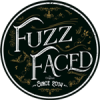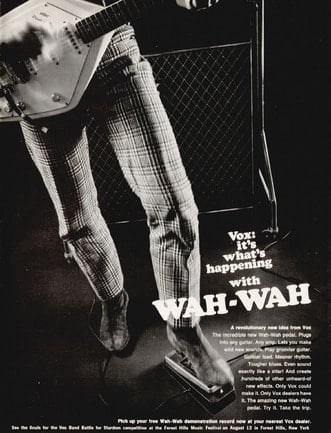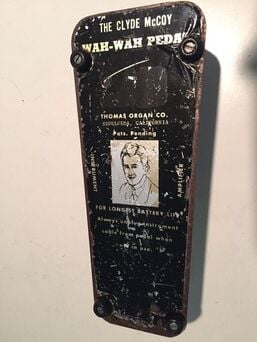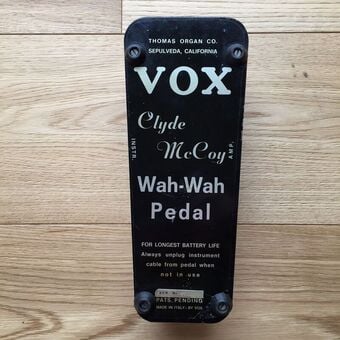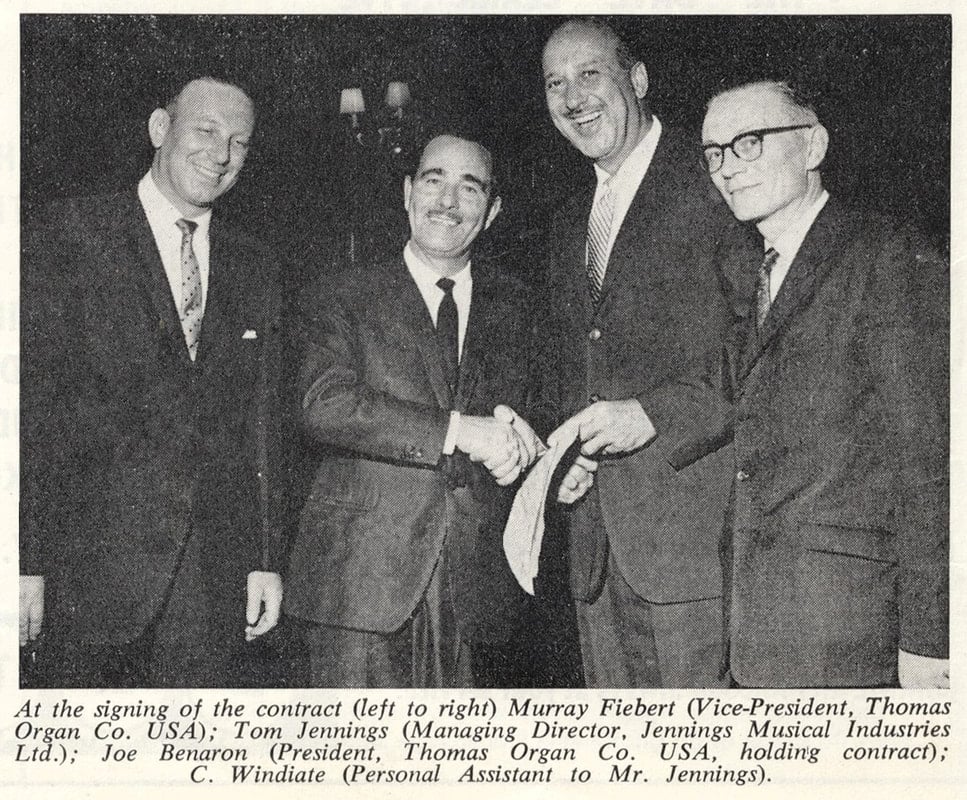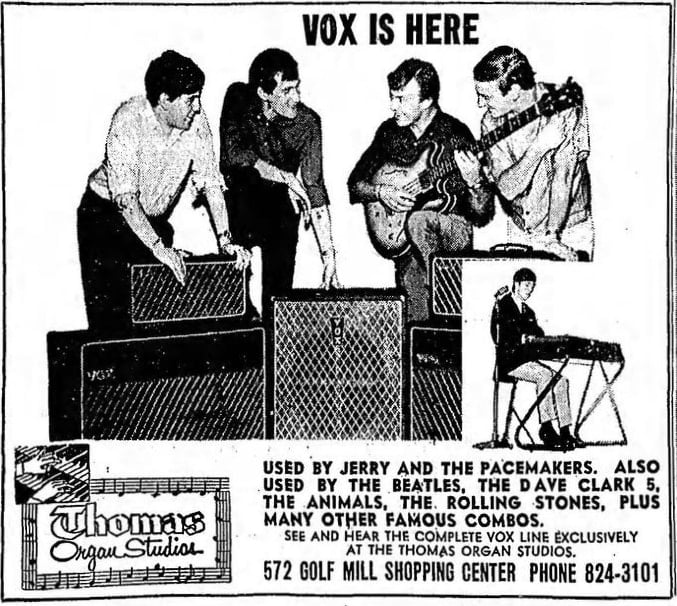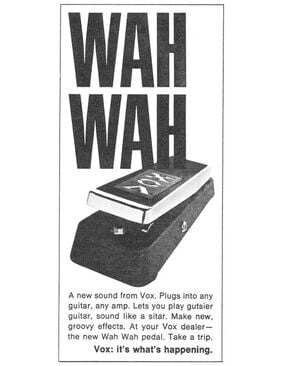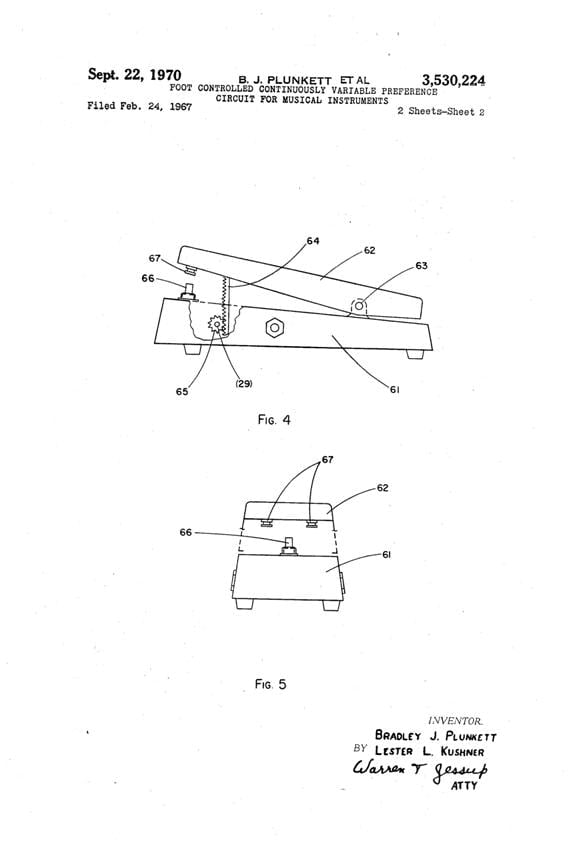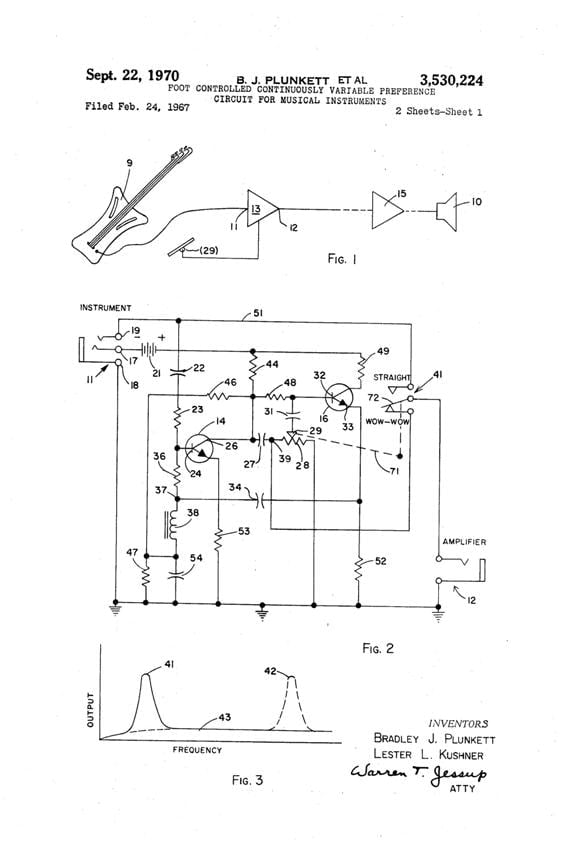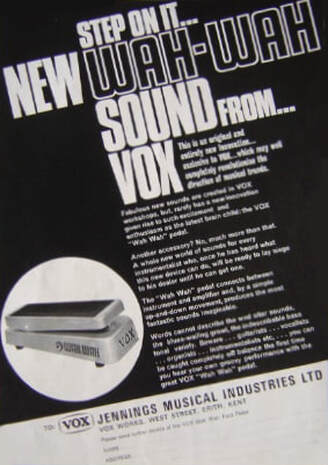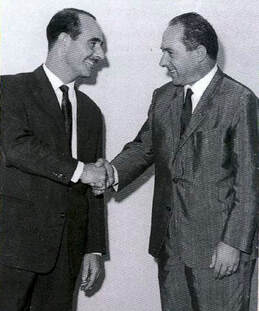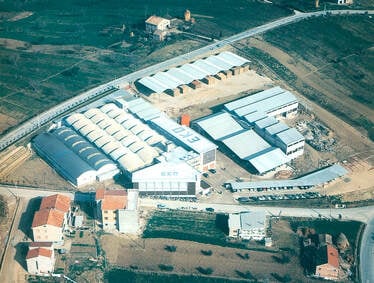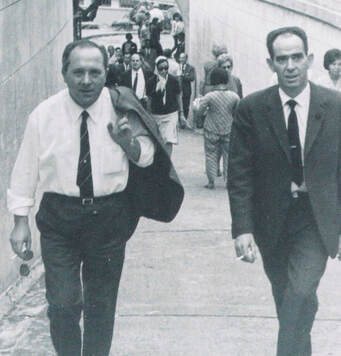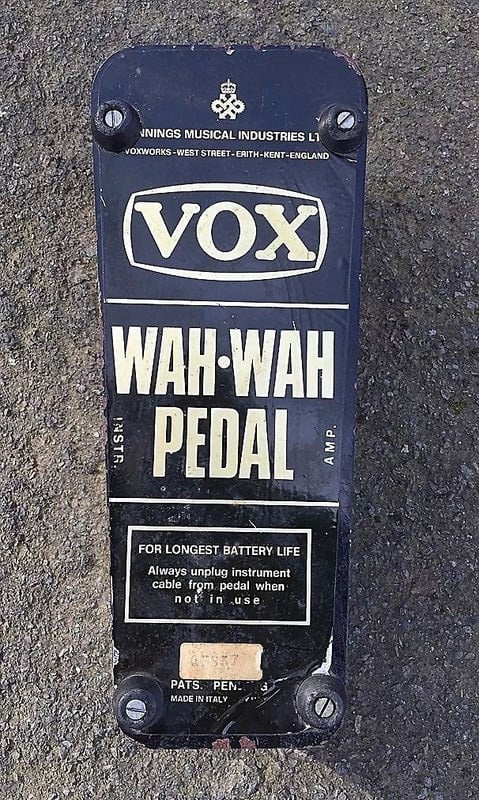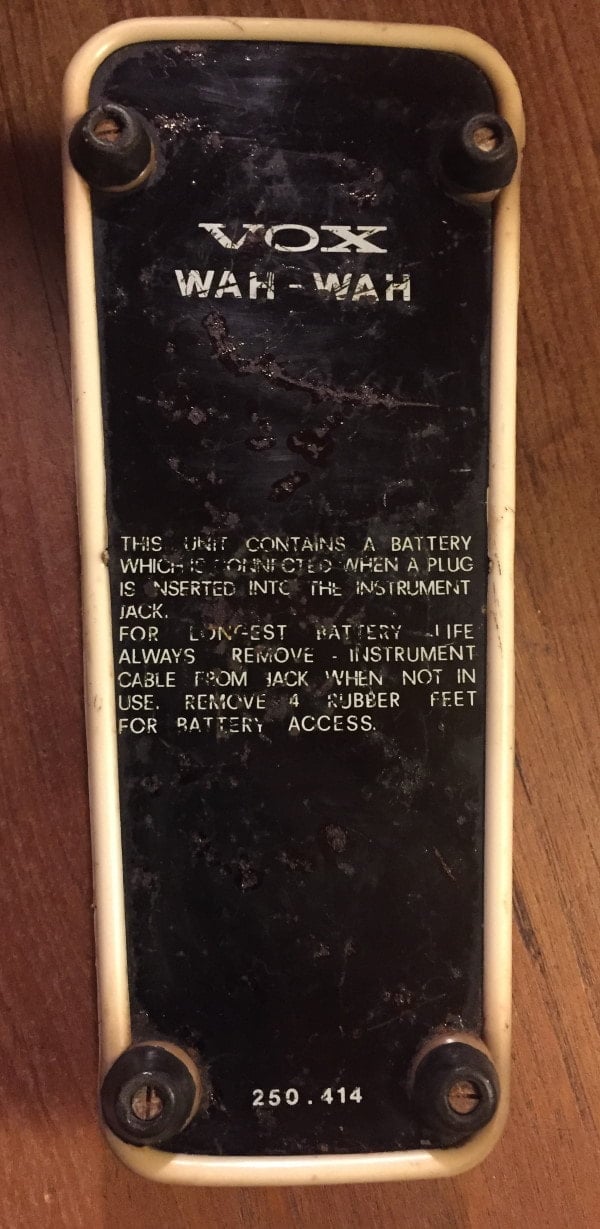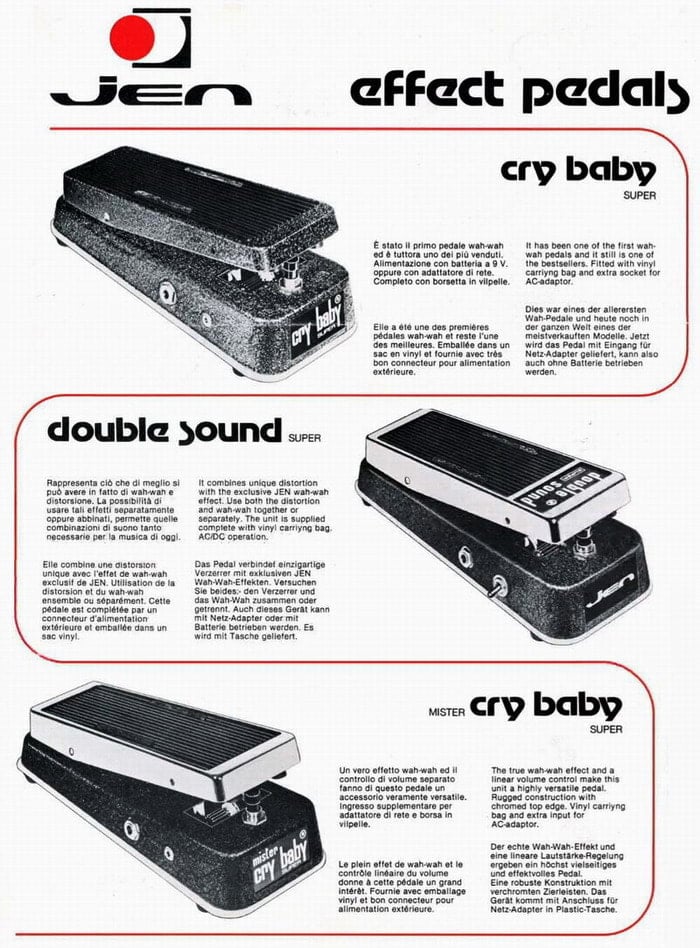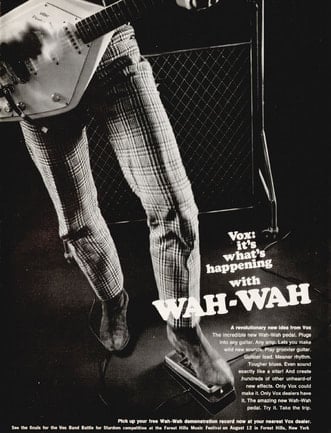 Vox Wah Wah pedal adversting flyer, 1967
Vox Wah Wah pedal adversting flyer, 1967
Probably the best known and most recognized electric guitar effect, even by non-experts, the "wah'' pedal modifies sound in a way that reminds many of a baby's crying. It probably made its commercial debut with Tales of Brave Ulysses on Eric Clatpon's 1967 album Disraeli Gears, and reached maximum popularity with Jimi Hendrix's Voodoo Child (Slight Return). But there have been musicians, even in musical genres other than rock, such as Bob Marley, who have used this effect extensively.
It was first marketed in the second half of the 1960s by the American Thomas Organ Company of Sepulveda, California, under the name of Clyde McCoy Wah. It owes its name to the trumpet player Clyde McCoy who, at the beginning of the 1920s, had already obtained this particular sound by rhythmically moving the mute of his trumpet.
Two wah pedals were initially sold almost simultaneously: the Clyde McCoy Picture, so called because the trumpeter's effigy was on the bottom plate and it is believed to have been the first in chronological order, and the Clyde McCoy Signature (or Script), on which only his name appeared.
As happens with many instruments, amplifiers or guitar effects that have made the history of music, there are numerous legends circulating about the birth of the wah and the protagonists all tell different versions, so it is not possible to establish who holds the greatest merit for its design. The most likely thing is that each of them made their contribution to the creation of this pedal.
It was first marketed in the second half of the 1960s by the American Thomas Organ Company of Sepulveda, California, under the name of Clyde McCoy Wah. It owes its name to the trumpet player Clyde McCoy who, at the beginning of the 1920s, had already obtained this particular sound by rhythmically moving the mute of his trumpet.
Two wah pedals were initially sold almost simultaneously: the Clyde McCoy Picture, so called because the trumpeter's effigy was on the bottom plate and it is believed to have been the first in chronological order, and the Clyde McCoy Signature (or Script), on which only his name appeared.
As happens with many instruments, amplifiers or guitar effects that have made the history of music, there are numerous legends circulating about the birth of the wah and the protagonists all tell different versions, so it is not possible to establish who holds the greatest merit for its design. The most likely thing is that each of them made their contribution to the creation of this pedal.
The Million Dollar Deal
The foundations of the wah date back to August 1964, three years before its 1967 presentation, when the Thomas Organ Company and the British Jennings Musical Instruments (JMI) of Dartfort, Kent, owner of the Vox brand, made the Million Dollar Deal, an agreement in which the British company undertook to supply the American company with Vox instruments and amplifiers worth one million dollars. In the midst of Beatlemania and the Beatles' American tour, Thomas Organ was the exclusive distributor of Vox-branded products for the United States. This order was followed by others, between the end of 1964 and 1965, for a total of almost 10 million dollars!
However, due to the huge demand that came from all over the world following the British Invasion, JMI was only able to fulfill a small fraction of the orders that came from the United States. Also, due to the high costs, Thomas Organ was not making satisfactory profits from the import and distribution of Vox products. For this reason Joe Benaron, president of Thomas Organ, flew to London on October 2, 1965, during the last days of the British Musical Industry's Trade Fair, to meet the leaders of JMI and buy the exclusive rights of the Vox brand in the USA, so that he could modify the Vox amplifiers to his liking, since its components were too expensive, and to create new cheaper ones: transistor amps rather than tube ones.
However, due to the huge demand that came from all over the world following the British Invasion, JMI was only able to fulfill a small fraction of the orders that came from the United States. Also, due to the high costs, Thomas Organ was not making satisfactory profits from the import and distribution of Vox products. For this reason Joe Benaron, president of Thomas Organ, flew to London on October 2, 1965, during the last days of the British Musical Industry's Trade Fair, to meet the leaders of JMI and buy the exclusive rights of the Vox brand in the USA, so that he could modify the Vox amplifiers to his liking, since its components were too expensive, and to create new cheaper ones: transistor amps rather than tube ones.
WHO INVENTED THE WAH PEDAL?
THE OFFICIAL VERSION: BRAD PLUNKETT
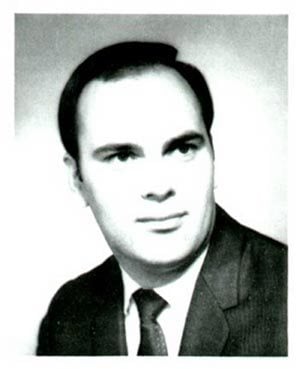 Brad Plunkett
Brad Plunkett
A peculiar characteristic of the new American transistor Vox amplifiers was the MRB, acronym for Mid Range Resonant Boost, an effect that generated a mid-boost on some preset frequencies selectable via a switch, which was also subsequently put onto the British Vox amplifiers.
After a visit that Vox chief engineer Dick Denney made to the American factory in late 1965, Stan Cutler, chief engineer of Thomas Organ, presented the MRB circuit in a letter to Tom Jennings, president of JMI Vox, using - perhaps for the first time - the term "wah" to describe its sound: “An interesting wah-wah effect is obtained by operating the boost switch between the two positions. A remote control for this at the guitar would be novel, however, the cost and complication would probably be high.” The letter is published in the book The Vox Story by David Peterson and Dick Denney.
However, Thomas Organ still wanted to cut costs, so they asked Bradley J. Plunkett (aka Brad) to replace the expensive MRB three-way rotary switch with a potentiometer: “One day, my boss led me to a guitar amplifier that had a feature on it called midrange boost. It was a haystack equalization that you could move to four, five, six individual frequencies to change the tonality of the guitar amplifier. I think it was a Vox Buckingham but I'm not absolutely sure. His order was, ‘This rotary switch that we have for switching these frequencies on this equalizer is too expensive. I want you to take it out and figure out a way to replace it with a potentiometer,’” declared Brad, interviewed by Marsha Vdovin, for the Universal Audio WebZine. The result was that the boost was no longer on three predefined frequencies, but it was variable and continuous. Brad declared, in the documentary Cry Baby: the Pedal that Rocks the World, that he asked his friend and guitarist John McGlennon to bring a guitar to his laboratory to test the prototype had just been completed: “So I went next door and asked a friend of mine, John McGlennon, if he would plug his guitar into the pile of wires and resistors and capacitors I had on the bench. He strummed a couple of chords and I turned the knob on the potentiometer and it went wack, wack, wack, and we looked at each other and - I won't tell you exactly the words we said - we said, ‘Wow, this is really great!’” Both were so enthusiastic about the result they got with the guitar that Brad decided to mount the new MRB circuit on an organ volume pedal, so that guitarists could change the frequency with the simple movement of the foot: “We started thinking about, ‘Well, how's the guitarist going be able to operate this thing? His hands are already busy.’ There was a Vox Jaguar organ sitting in front of one of the other engineers’ benches, so I said, ‘Hey John, go steal that volume pedal from Frank's organ! Let's put the pot in there.’ And pretty soon, we were drawing a modest crowd and everybody said it sounded pretty good.”
After a visit that Vox chief engineer Dick Denney made to the American factory in late 1965, Stan Cutler, chief engineer of Thomas Organ, presented the MRB circuit in a letter to Tom Jennings, president of JMI Vox, using - perhaps for the first time - the term "wah" to describe its sound: “An interesting wah-wah effect is obtained by operating the boost switch between the two positions. A remote control for this at the guitar would be novel, however, the cost and complication would probably be high.” The letter is published in the book The Vox Story by David Peterson and Dick Denney.
However, Thomas Organ still wanted to cut costs, so they asked Bradley J. Plunkett (aka Brad) to replace the expensive MRB three-way rotary switch with a potentiometer: “One day, my boss led me to a guitar amplifier that had a feature on it called midrange boost. It was a haystack equalization that you could move to four, five, six individual frequencies to change the tonality of the guitar amplifier. I think it was a Vox Buckingham but I'm not absolutely sure. His order was, ‘This rotary switch that we have for switching these frequencies on this equalizer is too expensive. I want you to take it out and figure out a way to replace it with a potentiometer,’” declared Brad, interviewed by Marsha Vdovin, for the Universal Audio WebZine. The result was that the boost was no longer on three predefined frequencies, but it was variable and continuous. Brad declared, in the documentary Cry Baby: the Pedal that Rocks the World, that he asked his friend and guitarist John McGlennon to bring a guitar to his laboratory to test the prototype had just been completed: “So I went next door and asked a friend of mine, John McGlennon, if he would plug his guitar into the pile of wires and resistors and capacitors I had on the bench. He strummed a couple of chords and I turned the knob on the potentiometer and it went wack, wack, wack, and we looked at each other and - I won't tell you exactly the words we said - we said, ‘Wow, this is really great!’” Both were so enthusiastic about the result they got with the guitar that Brad decided to mount the new MRB circuit on an organ volume pedal, so that guitarists could change the frequency with the simple movement of the foot: “We started thinking about, ‘Well, how's the guitarist going be able to operate this thing? His hands are already busy.’ There was a Vox Jaguar organ sitting in front of one of the other engineers’ benches, so I said, ‘Hey John, go steal that volume pedal from Frank's organ! Let's put the pot in there.’ And pretty soon, we were drawing a modest crowd and everybody said it sounded pretty good.”
THE VERSION OF DEL CASHER
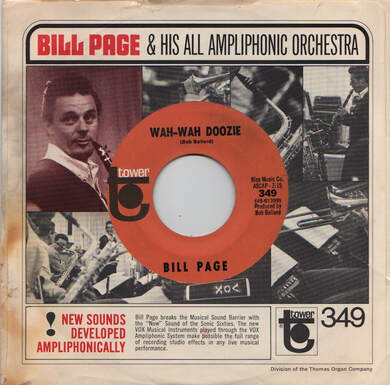
The version told by the guitarist with a passion for electronics, Del Casher, was different. He was hired in 1966 by Thomas Organ as a consultant to develop their guitar products and to join the Vox Ampliphonic Orchestra led by Bill Page, who Del met during a performance on Lawrence Welk's TV show. The aim of this big band was to equip all musicians, including saxophonists, trumpet players and percussionists, with amps, pickups and effects from the American Vox Ampliphonic line to promote the brand.
Del noticed that turning a tone knob (the MRB one) on his amplifier produced an interesting sound that tickled his imagination. He then decided to try and modify the MRB circuit and insert it into a pedal he had taken from the organ division, in order to make a guitar effect: “As I was rehearsing using the new amp with the band, I noticed my amp had one control that said 'Tone', but had an interesting sound; as I turned the knob it made a 'wah' sound, which was exactly what I was looking for. I knew I had stumbled onto something revolutionary and wanted that circuit converted into a pedal,” he said in an interview with Dave Hunter for Vintage Guitar Magazine in April 2016.
Del noticed that turning a tone knob (the MRB one) on his amplifier produced an interesting sound that tickled his imagination. He then decided to try and modify the MRB circuit and insert it into a pedal he had taken from the organ division, in order to make a guitar effect: “As I was rehearsing using the new amp with the band, I noticed my amp had one control that said 'Tone', but had an interesting sound; as I turned the knob it made a 'wah' sound, which was exactly what I was looking for. I knew I had stumbled onto something revolutionary and wanted that circuit converted into a pedal,” he said in an interview with Dave Hunter for Vintage Guitar Magazine in April 2016.
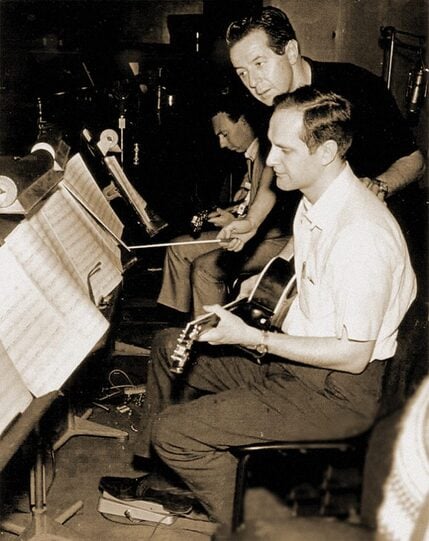 Casher playing a Gibson L-4 through his grey shell prototype wah with custom circuit and specs, during a session at Universal Studios in February of 1967.
Casher playing a Gibson L-4 through his grey shell prototype wah with custom circuit and specs, during a session at Universal Studios in February of 1967.
Del talked to Stan Cutler, who joined engineers Brad Plunkett and Lester Kushner. Together they began working on the new pedal to get the sound Del had in mind: “After he installed the circuit, I played my guitar with the pedal, making an awesome wah sound, but it was a little too harsh. I asked Brad to change the values of caps and resistors several times that day to mellow the sound. He was a little annoyed because he did not understand what I was doing or looking for.” Obviously this took a long time, so much so that Stan began to get impatient, reminding Del Casher that he was wasting Brad’s time on something that had nothing to do with Vox products. But Del asked him to be patient.
Finally, after many attempts, the new pedal was ready. However, according to what Del Casher told Tom Huges for the book Analogman Guide to Vintage Effects, he was the only one who could play the guitar in the laboratory, there was no one else, so no one accidentally connected the pedal to the guitar, therefore also contradicting what Brad Plunkett said when he saw John McGlennon on guitar: “Some stories I have read say somebody plugged a guitar into this pedal. [...] Well, there was no one else in that lab who knew how to play a guitar.” Many heard this new sound that was so reminiscent of the human voice, they walked in and asked what they were hearing, and Del replied: “This is the wahwah pedal!”
Actually, this version does not coincide much with what Del Casher said many years earlier, interviewed by Willie G. Moseley for the February 1997 edition of Vintage Guitar Magazine, in which he said he had received the prototype of the wah-wah from Stan Cutler: “I was always looking for a new sound for the guitar. I got a call from the Thomas Organ Company, which owned Vox Guitars. They said they had a new pedal they wanted me to try. I told them I didn't think I was interested, but they insisted. I was given the prototype wah-wah pedal by Stan Cutler, Vox's engineer, and the minute I plugged in my guitar I said, ‘This is brilliant! It had a very narrow band, so the “cut” for the midrange of the guitar was extreme.’ Stan told me to take it home and play it for a few days. I called him back the very next morning and told him I couldn’t give it back.”
Finally, after many attempts, the new pedal was ready. However, according to what Del Casher told Tom Huges for the book Analogman Guide to Vintage Effects, he was the only one who could play the guitar in the laboratory, there was no one else, so no one accidentally connected the pedal to the guitar, therefore also contradicting what Brad Plunkett said when he saw John McGlennon on guitar: “Some stories I have read say somebody plugged a guitar into this pedal. [...] Well, there was no one else in that lab who knew how to play a guitar.” Many heard this new sound that was so reminiscent of the human voice, they walked in and asked what they were hearing, and Del replied: “This is the wahwah pedal!”
Actually, this version does not coincide much with what Del Casher said many years earlier, interviewed by Willie G. Moseley for the February 1997 edition of Vintage Guitar Magazine, in which he said he had received the prototype of the wah-wah from Stan Cutler: “I was always looking for a new sound for the guitar. I got a call from the Thomas Organ Company, which owned Vox Guitars. They said they had a new pedal they wanted me to try. I told them I didn't think I was interested, but they insisted. I was given the prototype wah-wah pedal by Stan Cutler, Vox's engineer, and the minute I plugged in my guitar I said, ‘This is brilliant! It had a very narrow band, so the “cut” for the midrange of the guitar was extreme.’ Stan told me to take it home and play it for a few days. I called him back the very next morning and told him I couldn’t give it back.”
Clyde McCoy, Cry Baby, V846 and King Vox Wah
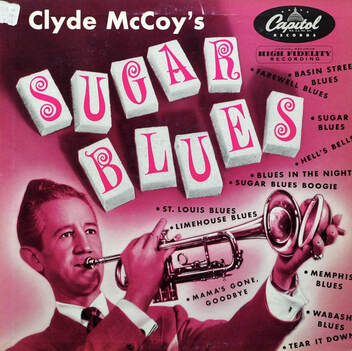 Clyde McCoy on the cover of his Sugar Blues
Clyde McCoy on the cover of his Sugar Blues
However, things really went, when Joe Benaron heard Del Casher try the new effect, he was convinced that this pedal had to be sold as an accessory of the Ampliphonic line for winds, without taking into account the world of electric guitars.
It seems that it was Del Casher himself who told Joe that the wah pedal resembled the sound of Clyde McCoy's trumpet on Sugar Blues. Del was joking; however, Joe took him seriously and contacted the trumpet player offering him $ 500 to use his name for the pedal.
Del Casher and other Thomas Organ employees were unconvinced of Benaron's decision to limit wah use to the Vox Ampliphonic line. “This is a guitar thing,” said Del. Frustrated to see the wah relegated to horns alone, Del took the prototype to his garage/studio in Hollywood Hills telling Joe that he wanted to record a promotional record with the new pedal. In November 1966, with Jimmie Troxel on drums, Del recorded ten tracks showing the use of wah with the guitar in ten different musical styles. Only at this point Joe Benaron understood the real potential of the pedal as an accessory for the electric guitar, removed the name 'Clyde McCoy' from the pedal and called it Vox V846 Wah Wah. Joe sent about 5000 copies of the vinyl to as many vendors and at the same time began the production of the new pedal without any reference to the trumpeter. The term Vox Wah Wah Pedal first appeared in 1967 in Bruce Weber's presentation of the pedal in the April 8 edition of Billboard Magazine, and the first advertising flyers were printed for the April 22 edition of Melody Maker. However, for a few months, wah-wah pedals with the old and new names were produced at the same time.
It seems that it was Del Casher himself who told Joe that the wah pedal resembled the sound of Clyde McCoy's trumpet on Sugar Blues. Del was joking; however, Joe took him seriously and contacted the trumpet player offering him $ 500 to use his name for the pedal.
Del Casher and other Thomas Organ employees were unconvinced of Benaron's decision to limit wah use to the Vox Ampliphonic line. “This is a guitar thing,” said Del. Frustrated to see the wah relegated to horns alone, Del took the prototype to his garage/studio in Hollywood Hills telling Joe that he wanted to record a promotional record with the new pedal. In November 1966, with Jimmie Troxel on drums, Del recorded ten tracks showing the use of wah with the guitar in ten different musical styles. Only at this point Joe Benaron understood the real potential of the pedal as an accessory for the electric guitar, removed the name 'Clyde McCoy' from the pedal and called it Vox V846 Wah Wah. Joe sent about 5000 copies of the vinyl to as many vendors and at the same time began the production of the new pedal without any reference to the trumpeter. The term Vox Wah Wah Pedal first appeared in 1967 in Bruce Weber's presentation of the pedal in the April 8 edition of Billboard Magazine, and the first advertising flyers were printed for the April 22 edition of Melody Maker. However, for a few months, wah-wah pedals with the old and new names were produced at the same time.
On February 24, 1967, Thomas Organ filed the patent for the "Foot Controlled Continuously Variable Preference Circuit for Musical Instruments,'' in the name of Bradley J. Plunkett and Lester L. Kushner (leaving Del Casher out), which was approved on September 22, 1970, with the number 3,530,224. At the same time, it gave JMI the opportunity to replicate the circuit to produce the same pedal. In fact, already in the 48th edition of the Beat Instrumental dated April 1967 there was talk of the new Vox Wah Wah available in England by the end of the month. About 2,000 pedals were built at Erith's Vox Works from about March 1967 until early 1968, aesthetically very different from the American ones and similar, in their gray shell, to the pedals used by Thomas Organ for organs.
Unfortunately, the mere filing of the patent was not sufficient to protect the invention of the wah-wah from unapproved copies, and in a short time other companies, such as Gibson with the Maestro Boomerang, put similar pedals on the market. JMI responded by allowing the Vox Wah Wah to be sold only to authorized Vox dealers. At the same time, to expand the market, Thomas Organ was given the opportunity to sell the same pedal under the name Cry Baby, for which Del Casher made a new promotional recording, to vendors who did not have the Vox product line. Obviously Thomas Organ also continued to distribute the original V846 Vox Wah-Wah and the King Vox Wah (intended for wind instruments) to authorized dealers, as can be seen from the Thomas Vox list dated February 1970.
The Italian Wah
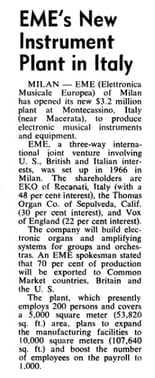
The connection between the wah and Italy dates back to the early 1960s. Tom Jennings was a fan of organs and accordions - it is no coincidence that Tom's first company was called Jennings Organ Company - and he eagerly followed keyboard instrument manufacturers that had a long and glorious tradition in Italy. In 1964, the skill of Italian artisans and low cost of labor in Italy, led Tom to found the EME, acronym for European Musical Electronics, a joint venture between JMI, Thomas Organ and Eko, an Italian company in Recanati famous for the production of guitars, founded in 1960 by Oliviero Pigini. EME, based in Milan, manufactured organs for Vox in Recanati, while, since 1966, the distribution of Eko instruments, Vox and Thomas Organ organs, was entrusted to Comusik. The Recanati factory was partially destroyed in a fire in 1966, so in 1967 the new factory was inaugurated in Montecassiano, Macerata. Unfortunately, at the beginning of 1967 Oliviero Pigini died in a car accident and Ennio Uncini, who had contributed to the development of Eko, took his place as the new president of EME.
In the article on the left, extracted from the Billboard magazine edition dated November 2 1968, which talks about the new EME factory, there is a typo: it is not Montecassino, but Montecassiano.
In the article on the left, extracted from the Billboard magazine edition dated November 2 1968, which talks about the new EME factory, there is a typo: it is not Montecassino, but Montecassiano.
The production of the Italian Vox Wah Wah began in the Montecassiano factory. It was aesthetically very similar to those made in the USA. Some of these pedals manufactured in Italy in 1967 showed the "Queen's Award" emblem on the base plate, an honor awarded to JMI in April 1967 for exporting musical instruments to more than 70 countries around the world for a value of 750,000 pounds!
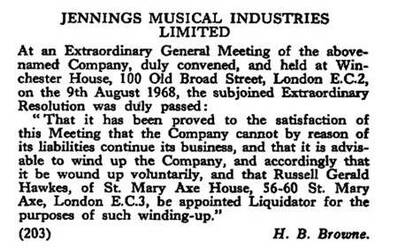 1968 London Gazette, 29 August 1968
1968 London Gazette, 29 August 1968
Due to the financial crisis that hit the Royston Group, which had controlled JMI since 1964, and the stalled sales in the United States, in 1968 Joe Benaron, with the intention of cutting production costs, decided to move the production of the Vox Wah-Wah, King Vox Wah and Thomas Organ Cry Baby to Italy.
Shortly after, Uncini resigned from EME and formed Jen Elettronica with Benaron, in Pescara. The name derives from Joe Benaron and Ennio Uncini, who continued to produce wah wah pedals for Vox and Thomas Organ, instead of EME.
In the 1970s (until 1978) Jen continued to export to the US and UK the Vox Wah Wah, the Vox Wah Swell (a wah with volume) and the Vox Stereo Fuzz Wah (a wah with fuzz), and expanded the production of wah pedals by selling the Cry Baby Super (equipped with a mains adapter), the Mister Cry Baby Super (which additionally had a volume control) and the Double Sound Super (an effect that combined the wah and the distortion). The Vox wahwah made in Italy in the '70s can be recognized, even without the label of origin, by a small white rubber tube that surrounds the plate at the base of the pedal.
The production of the Thomas Organ branded Cry Baby and King returned to the United States, first in the Sepulveda factory, until about 1977, then in the Chicago one until the end of 1980. The Cry Baby Stereo Fuzz Wah was added to these two pedals.
The Cry Baby brand was later acquired by Dunlop.
Shortly after, Uncini resigned from EME and formed Jen Elettronica with Benaron, in Pescara. The name derives from Joe Benaron and Ennio Uncini, who continued to produce wah wah pedals for Vox and Thomas Organ, instead of EME.
In the 1970s (until 1978) Jen continued to export to the US and UK the Vox Wah Wah, the Vox Wah Swell (a wah with volume) and the Vox Stereo Fuzz Wah (a wah with fuzz), and expanded the production of wah pedals by selling the Cry Baby Super (equipped with a mains adapter), the Mister Cry Baby Super (which additionally had a volume control) and the Double Sound Super (an effect that combined the wah and the distortion). The Vox wahwah made in Italy in the '70s can be recognized, even without the label of origin, by a small white rubber tube that surrounds the plate at the base of the pedal.
The production of the Thomas Organ branded Cry Baby and King returned to the United States, first in the Sepulveda factory, until about 1977, then in the Chicago one until the end of 1980. The Cry Baby Stereo Fuzz Wah was added to these two pedals.
The Cry Baby brand was later acquired by Dunlop.
VOX IN THE 1970s
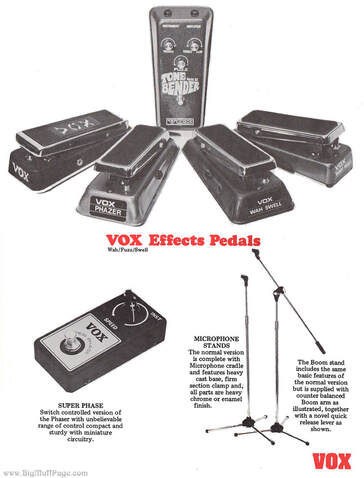 1975 Dallas Arbiter Vox pedals
1975 Dallas Arbiter Vox pedals
In January 1970, Vox Instrument Equipment Limited (VSEL), which had saved itself from the crash of the Royston Group by separating from JMI and, being managed by the Corinthian Securities banking group, was also put into receivership and was bought in February by Michael Birch, who saved the Vox brand by changing the VSEL to Vox Sound Limited (VSL).
In the early summer of 1970 the Birch group and George Stow's Stolec group merged and the Birch-Stolec group was born, which controlled the Vox brand until 1973. In 1971 the production of Vox pedals was moved from the Erith factory to Birch-Stolec in Hastings (St-Leonards-on-Sea). Other ownership changes followed, including Cosmocord Limited, Dallas-Arbiter (under which the factory was moved to Vanguard Industrial Estate, Shoeburyness) and Rose Morris.
Between 1970 and 1978 the wah pedals of Vox Sound Equipment Limited and Vox Sound Limited were built in Italy by Jen (easily recognizable by the Vox brand on the foot-plate) and in England by Sola Sound.
In addition to the Vox Wah Wah, Sola Sound also manufactured the Wow Fuzz (later renamed Wah-Fuzz) and the Wow Swell (which changed to Wah-Swell), both built by Sola Sound. During the Dallas-Arbiter period, the Wah-Fuzz-Swell was also added.
In the early summer of 1970 the Birch group and George Stow's Stolec group merged and the Birch-Stolec group was born, which controlled the Vox brand until 1973. In 1971 the production of Vox pedals was moved from the Erith factory to Birch-Stolec in Hastings (St-Leonards-on-Sea). Other ownership changes followed, including Cosmocord Limited, Dallas-Arbiter (under which the factory was moved to Vanguard Industrial Estate, Shoeburyness) and Rose Morris.
Between 1970 and 1978 the wah pedals of Vox Sound Equipment Limited and Vox Sound Limited were built in Italy by Jen (easily recognizable by the Vox brand on the foot-plate) and in England by Sola Sound.
In addition to the Vox Wah Wah, Sola Sound also manufactured the Wow Fuzz (later renamed Wah-Fuzz) and the Wow Swell (which changed to Wah-Swell), both built by Sola Sound. During the Dallas-Arbiter period, the Wah-Fuzz-Swell was also added.
Antonio Calvosa
